
A forge is a type of hearth used for heating metals, or the workplace (smithy) where such a hearth is located. The forge is used by the smith to heat a piece of metal to a temperature at which it becomes easier to shape by forging, or to the point at which work hardening no longer occurs. The metal is transported to and from the forge using tongs, which are also used to hold the workpiece on the smithy's anvil while the smith works it with a hammer. Sometimes, such as when hardening steel or cooling the work so that it may be handled with bare hands, the workpiece is transported to the slack tub, which rapidly cools the workpiece in a large body of water. However, depending on the metal type, it may require an oil quench or a salt brine instead; many metals require more than plain water hardening. The slack tub also provides water to control the fire in the forge.

Smoking is the process of flavoring, browning, cooking, or preserving food by exposing it to smoke from burning or smoldering material, most often wood. Meat, fish, and lapsang souchong tea are often smoked.
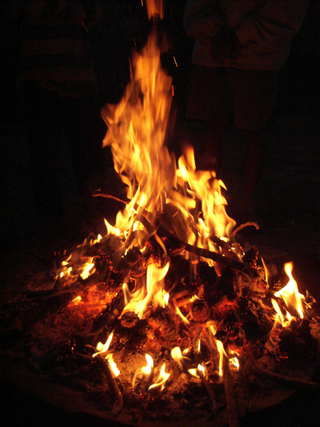
A campfire is a fire at a campsite that provides light and warmth, and heat for cooking. It can also serve as a beacon, and an insect and predator deterrent. Established campgrounds often provide a stone or steel fire ring for safety. Campfires are a popular feature of camping. At summer camps, the word campfire often refers to an event at which there is a fire. Some camps refer to the fire itself as a campfire.

Incineration is a waste treatment process that involves the combustion of substances contained in waste materials. Industrial plants for waste incineration are commonly referred to as waste-to-energy facilities. Incineration and other high-temperature waste treatment systems are described as "thermal treatment". Incineration of waste materials converts the waste into ash, flue gas and heat. The ash is mostly formed by the inorganic constituents of the waste and may take the form of solid lumps or particulates carried by the flue gas. The flue gases must be cleaned of gaseous and particulate pollutants before they are dispersed into the atmosphere. In some cases, the heat that is generated by incineration can be used to generate electric power.

A portable stove is a cooking stove specially designed to be portable and lightweight, used in camping, picnicking, backpacking, or other use in remote locations where an easily transportable means of cooking or heating is needed. Portable stoves can be used in diverse situations, such as for outdoor food service and catering and in field hospitals.

Outdoor cooking is the preparation of food in the outdoors. A significant body of techniques and specialized equipment exists for it, traditionally associated with nomad in cultures such as the Berbers of North Africa, the Arab Bedouins, the Plains Indians, pioneers in North America, and indigenous tribes in South America. These methods have been refined in modern times for use during recreational outdoor pursuits, by campers and backpackers.
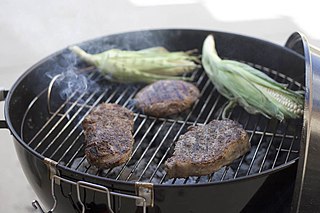
A barbecue grill or barbeque grill is a device that cooks food by applying heat from below. There are several varieties of grills, with most falling into one of three categories: gas-fueled, charcoal, or electric. There is debate over which method yields superior results.
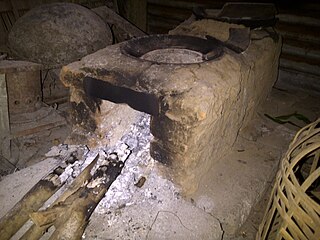
A stove or range is a device that generates heat inside or on top of the device, for local heating or cooking. Stoves can be powered with many fuels, such as electricity, natural gas, gasoline, wood, and coal.

Wood fuel is a fuel such as firewood, charcoal, chips, sheets, pellets, and sawdust. The particular form used depends upon factors such as source, quantity, quality and application. In many areas, wood is the most easily available form of fuel, requiring no tools in the case of picking up dead wood, or few tools, although as in any industry, specialized tools, such as skidders and hydraulic wood splitters, have been developed to mechanize production. Sawmill waste and construction industry by-products also include various forms of lumber tailings.
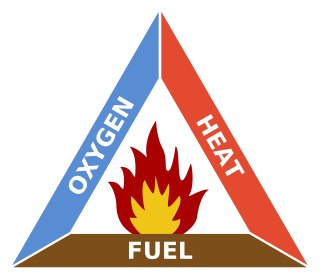
The fire triangle or combustion triangle is a simple model for understanding the necessary ingredients for most fires.
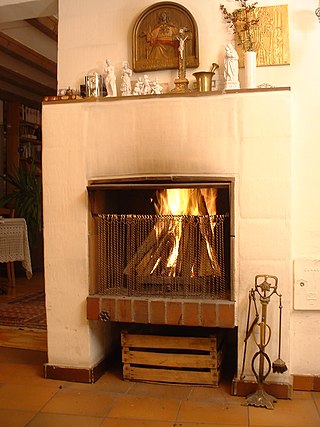
A fireplace or hearth is a structure made of brick, stone or metal designed to contain a fire. Fireplaces are used for the relaxing ambiance they create and for heating a room. Modern fireplaces vary in heat efficiency, depending on the design.
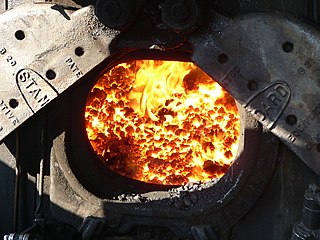
In a steam engine, the firebox is the area where the fuel is burned, producing heat to boil the water in the boiler. Most are somewhat box-shaped, hence the name. The hot gases generated in the firebox are pulled through a rack of tubes running through the boiler.

An earth oven, ground oven or cooking pit is one of the simplest and most ancient cooking structures. The earliest known earth oven was discovered in Central Europe and dated to 29,000 BC. At its most basic, an earth oven is a pit in the ground used to trap heat and bake, smoke, or steam food. Earth ovens have been used in many places and cultures in the past, and the presence of such cooking pits is a key sign of human settlement often sought by archaeologists. Earth ovens remain a common tool for cooking large quantities of food where no equipment is available. They have been used in various civilizations around the world and are still commonly found in the Pacific region to date.

A masonry heater is a device for warming an interior space through radiant heating, by capturing the heat from periodic burning of fuel, and then radiating the heat at a fairly constant temperature for a long period. Masonry heaters covered in tile are called cocklestoves. The technology has existed in different forms, from back into the Neoglacial and Neolithic periods. Archaeological digs have revealed excavations of ancient inhabitants utilizing hot smoke from fires in their subterranean dwellings, to radiate into the living spaces. These early forms have evolved into modern systems.
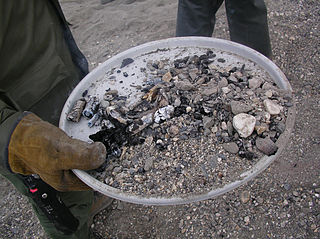
A fire pan is a pan for holding or conveying fire. The use of a fire pan reduces the impact to the ground, vegetation and rocks, and its compact size results in the burning of less wood. Fire pans also allow users to easily burn their accumulated garbage although the best practice is to only burn paper. Combustible items will be reduced to ash. A fire pan user can leave no trace of the fire, as the ashes can be collected and buried.
A fire pot is a container, usually earthenware, for carrying fire. Fire pots have been used since prehistoric times to transport fire from one place to another, for warmth while on the move, for cooking, in religious ceremonies and even as weapons of war.

Oxy-fuel welding and oxy-fuel cutting are processes that use fuel gases and oxygen to weld or cut metals. French engineers Edmond Fouché and Charles Picard became the first to develop oxygen-acetylene welding in 1903. Pure oxygen, instead of air, is used to increase the flame temperature to allow localized melting of the workpiece material in a room environment. A common propane/air flame burns at about 2,250 K, a propane/oxygen flame burns at about 2,526 K, an oxyhydrogen flame burns at 3,073 K and an acetylene/oxygen flame burns at about 3,773 K.
Home safety is the awareness of risks and potential dangers in and around a home that may cause bodily harm, injury, or even death to those living there.
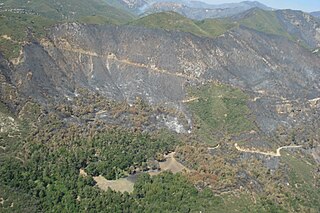
The Indians Fire was a wildfire in the Ventana Wilderness of the Los Padres National Forest in the Santa Lucia Range which that started on June 8, 2008 and burned uncontained until July 10 scorching 81,378 acres (329.33 km2) of land. This fire burned predominantly within the Los Padres National Forest, Monterey Ranger District, inside the Ventana Wilderness. Other affected properties include portions of Fort Hunter Liggett military base and private property. The suppression cost exceeded $40.7 million, not including resource damages and rehabilitation costs.

A charcoal pile or charcoal clamp is a carefully arranged pile of wood, covered by turf or other layer, inside which a fire is lit in order to produce charcoal. The pile is tended by a charcoal burner. It is similar to a charcoal kiln, but the latter is usually a permanent structure made of materials such as stone.





















